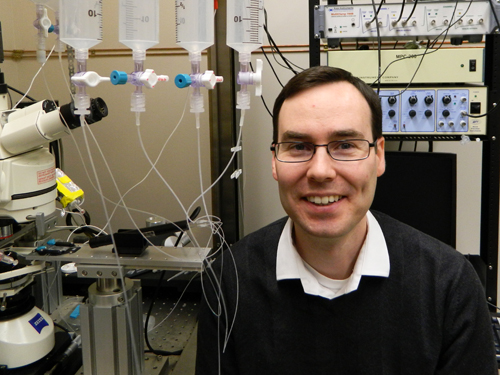
Biomedical sciences professor Craig Bailey has a short explanation for what goes on inside your brain: “One neuron pokes another with chemicals.”
That’s the simplified version, but Bailey can give you the long and complex version, too. He’s spent much of his career trying to understand how drugs and other elements in the environment affect the signals between neurons. “I like to look at a question about how the brain works from the cellular and molecular side all the way up to the behaviour related to that,” he says. “I like to study the whole picture.”
His first look was at the effects of prenatal alcohol exposure. Most people know that drinking alcohol while pregnant can be dangerous for the baby; Bailey wanted to know why. He used guinea pigs in his research and found that when the mothers were given alcohol, the babies had long-term changes in a certain chemical messenger in the brain.
“There is a chemical the brain uses to communicate among its own neurons, a chemical that can help the brain manage its activity so there is not too much excitement or stimulation,” says Bailey. “The chemical is received by specific receptors on the neurons. When the developing brain is exposed to alcohol, though, there are more of these receptors, and they are pharmacologically different.”
These findings may help explain some of the behavioural effects of prenatal alcohol exposure in humans, including deficits in cognition, attention, learning and problem-solving.
After graduation, Bailey headed to the University of Alabama at Birmingham to do a postdoc. “At Queen’s, I was looking at brain development, but this project looked at brain degeneration,” he explains. His main project studied Huntington’s disease and a specific enzyme in the brain that is thought to play a role in this genetic condition.
“We found that the mice we were studying who did not have this enzyme had a later onset of Huntington’s symptoms and lived longer than those who did have the enzyme,” Bailey says. “This helped identify the enzyme as a potential therapeutic target. Since Bailey left, other researchers have continued work on developing drugs to inhibit the enzyme.
Despite his enthusiasm for research, Bailey also had an interest in knowing more about drug development and the pharmaceutical industry. In 2006, he was hired by Novopharm (now Teva Canada), working in the company’s generic drug development division.
“New drugs are usually patented by the company that develops them,” explains Bailey, “but when the patents expire after 20 years, other companies can make and sell generic forms of them. Sometimes, though, even when the patent has not expired, another company will challenge its status for the right to make and sell a generic version of the drug.” Teva Canada has lawyers who look for chinks in the armour of the patents; Bailey worked with these lawyers to help build a case.
“It was very fast-paced and fascinating,” he says. “I worked closely with our research and development team and spent time at our lawyers’ offices and in court as well. And I learned a lot about the business.”
He describes that experience as “a practical MBA.” One of the most important things he learned was that his real home was in the research lab and classroom, not the boardroom. After two and a half years at Teva Canada, he took another postdoc position at the University of Toronto, studying the role that another chemical receptor plays in the development and function of the brain. Mice who did not have a specific variant of this receptor also had a lower response to the chemical messenger, and had trouble performing tasks that required the mice to pay attention, such as responding to a briefly flashing light.
“This particular receptor is a target for nicotine, and we know that exposure to nicotine while the brain is developing can lead to behavioural problems in humans, including deficits in attention,” says Bailey. “I plan to further investigate this receptor’s role in these problems.”
Now at U of G, Bailey says he is eager to continue his research into normal and abnormal brain development. He’s delighted that some of the specialized equipment he needs is already available in the Department of Biomedical Sciences.
Bailey loves to be outdoors and is looking forward to exploring the conservation areas and trails in the community. “I’m happy to be at the University of Guelph,” he says. “I’m also excited about the opportunities for collaboration here. Everyone I’ve met has been friendly and helpful; Guelph is exactly what I was looking for.”